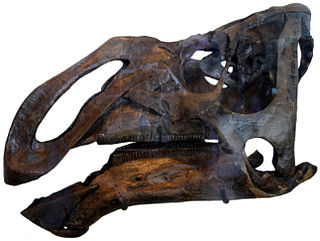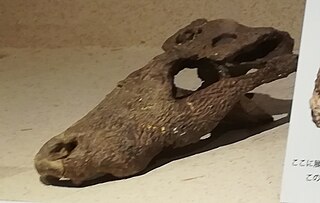
Kritosaurus is an incompletely known genus of hadrosaurid (duck-billed) dinosaur. It lived about 74.5-66 million years ago, in the Late Cretaceous of North America. The name means "separated lizard", but is often mistranslated as "noble lizard" in reference to the presumed "Roman nose".

Miacis is a genus of extinct carnivorous mammals that appeared in the late Paleocene and continued through the Eocene. The genus Miacis is not monophyletic but a diverse collection of species that belong to the stemgroup within the Carnivoramorpha. As such, most Miacis species belong to the group of early carnivores that represent the ancestors of the modern order, the crown-group Carnivora. However, the species Miacis cognitus is placed not in the stem-group but among the Caniformia, one of the two suborders of the crown-group Carnivora.

The Kirtland Formation is a sedimentary geological formation.

Ceratosuchus is an extinct genus of alligatorine crocodylian from latest Paleocene rocks of Colorado's Piceance Basin and earliest Eocene rocks of Wyoming's Bighorn Basin in North America, a slice of time known as the Clarkforkian North American Land Mammal Age. Like its modern relatives, Ceratosuchus was a swamp-dwelling predator. It is named for the pair of flattened, triangular bony plates that extend from the back of its head.
Paleontology or palaeontology is the study of prehistoric life forms on Earth through the examination of plant and animal fossils. This includes the study of body fossils, tracks (ichnites), burrows, cast-off parts, fossilised feces (coprolites), palynomorphs and chemical residues. Because humans have encountered fossils for millennia, paleontology has a long history both before and after becoming formalized as a science. This article records significant discoveries and events related to paleontology that occurred or were published in the year 2003.
Wannaganosuchus is an extinct genus of small alligatorid crocodylian. It was found in Late Paleocene-age rocks of Billings County, North Dakota, United States.

Hassiacosuchus is an extinct genus of small alligatorid from the early Eocene of Germany, found at the Messel pit. It was named in 1935 by K. Weitzel, and the type species is H. haupti. A second species, H. kayi, was named in 1941 by C.C. Mook for material from the Bridgerian of Wyoming, but was reassigned to Procaimanoidea in 1967 by Wassersug and Hecht. Hassiacosuchus may be the same as Allognathosuchus; Christopher Brochu has recommended continuing to use Hassiacosuchus.

Akanthosuchus is an extinct genus of alligatoroid crocodilian, possibly an alligatorine. Its fossils are found in the Paleocene-age Nacimiento Formation of the San Juan Basin, New Mexico, USA. It is known from a partial skeleton and isolated bony armor. Its armor was distinctive, with spike-shaped and blade-shaped pieces, and it is the only known crocodilian with a combination of both.

The Aguja Formation is a geological formation in North America, exposed in Texas, United States and Chihuahua and Coahuila in Mexico, whose strata date back to the Late Cretaceous. Dinosaur remains are among the fossils that have been recovered from the formation.

Allognathosuchus is an extinct genus of alligatorine crocodylian with a complicated taxonomic history. It was named in 1921.

Navajosuchus is an extinct genus of alligatorine crocodylian. Its fossils have been found in the Paleocene-age Nacimiento Formation of the San Juan Basin, New Mexico. It was named in 1942 by Charles C. Mook, and the original type species was N. novomexicanus. N. novomexicanus was based on AMNH 5186, a partial skull collected in 1913. Later research showed that Navajosuchus novomexicanus was the same as the earlier-named Allognathosuchus mooki. However, A. mooki does not belong to the genus Allognathosuchus, and so the name of the crocodilian becomes Navajosuchus mooki. Under whichever name is used, this animal would have been a generalized predator of the Nacimiento floodplains. It was the most common Nacimiento Formation crocodilian, found in both the Puercan and Torrejonian faunal assemblages.
Arambourgia is an extinct monotypic genus of alligatorine crocodylian from Europe. It was named in 1905 and synonymized with Allognathosuchus haupti in 1990, but later reassigned as its own genus once again in 2004. Arambourgia was likely to have been part of an early dispersal event of alligatorines from North America to Europe during the Eocene epoch. Arambourgia had non-serrated teeth and a deep orienirostral snout, unlike the flatter snouts of most other alligatorids.

Brachychampsa is an extinct genus of alligatoroid, possibly a basal caiman. Specimens have been reported from New Mexico, Colorado, Wyoming, Montana, North and South Dakota, New Jersey, and Saskatchewan, though only those from Montana, Utah, and New Mexico are based on material sufficient to justify the referral. One specimen has been reported from the Darbasa Formation of Kazakhstan, although the species status is indeterminate for the fossil. The genus first appeared during the late Campanian stage of the Late Cretaceous and became extinct during the late Maastrichtian stage of the Cretaceous. Brachychampsa is distinguished by an enlarged fifth maxillary tooth in the upper jaw.
Orthogenysuchus is an extinct genus of caimanine alligatorids. Fossils have been found from the Wasatch Beds of the Willwood Formation of Wyoming, deposited during the early Eocene. The type species is O. olseni. The holotype, known as AMNH 5178, is the only known specimen belonging to the genus and consists of a skull lacking the lower jaws. The braincase is filled in by the matrix and most of the suture lines between bones are indiscernible, making comparisons with other eusuchian material difficult.

Stangerochampsa is an extinct genus of globidontan alligatoroid, possibly an alligatorine or a stem-caiman, from the Late Cretaceous of Alberta. It is based on RTMP.86.61.1, a skull, partial lower jaws, and partial postcranial skeleton discovered in the late Campanian–early Maastrichtian-age Horseshoe Canyon Formation. Stangerochampsa was described in 1996 by Wu and colleagues. The type species is S. mccabei. The generic name honors the Stanger family, the owners of the ranch where the specimen was found, and the species name honors James Ross McCabe, who discovered, collected, and prepared it. Stangerochampsa is described as "small to medium–sized"; the type skull is 20.03 centimetres (7.89 in) long from the tip of the snout to the occipital condyle, and is 13.0 centimetres (5.1 in) wide at its greatest, while the thigh bone is 14.2 centimetres (5.6 in) long. It had heterodont dentition, with large crushing teeth at the rear of the jaws.

Alligator prenasalis is an extinct species of alligator from the Late Eocene period. It is well known, with many fossils having been collected from the Chadron and Brule Formations in South Dakota. The species was first named in 1904, but was originally classified as a crocodile in the genus Crocodilus. It was reassigned to the genus Alligator in 1918 on the basis of more complete material. It is the earliest known member of the genus Alligator.

Paleontology in Oklahoma refers to paleontological research occurring within or conducted by people from the U.S. state of Oklahoma. Oklahoma has a rich fossil record spanning all three eras of the Phanerozoic Eon. Oklahoma is the best source of Pennsylvanian fossils in the United States due to having an exceptionally complete geologic record of the epoch. From the Cambrian to the Devonian, all of Oklahoma was covered by a sea that would come to be home to creatures like brachiopods, bryozoans, graptolites and trilobites. During the Carboniferous, an expanse of coastal deltaic swamps formed in areas of the state where early tetrapods would leave behind footprints that would later fossilize. The sea withdrew altogether during the Permian period. Oklahoma was home a variety of insects as well as early amphibians and reptiles. Oklahoma stayed dry for most of the Mesozoic. During the Late Triassic, carnivorous dinosaurs left behind footprints that would later fossilize. During the Cretaceous, however, the state was mostly covered by the Western Interior Seaway, which was home to huge ammonites and other marine invertebrates. During the Cenozoic, Oklahoma became home to creatures like bison, camels, creodonts, and horses. During the Ice Age, the state was home to mammoths and mastodons. Local Native Americans are known to have used fossils for medicinal purposes. The Jurassic dinosaur Saurophaganax maximus is the Oklahoma state fossil.

The Wasatch Formation (Tw) is an extensive highly fossiliferous geologic formation stretching across several basins in Idaho, Montana Wyoming, Utah and western Colorado. It preserves fossils dating back to the Early Eocene period. The formation defines the Wasatchian or Lostcabinian, a period of time used within the NALMA classification, but the formation ranges in age from the Clarkforkian to Bridgerian.

The San Jose Formation is an Early Eocene geologic formation in the San Juan Basin of New Mexico and Colorado.

Coniophis is an extinct genus of snakes from the late Cretaceous period. The type species, Coniophis precedes, was about 7 cm long and had snake-like teeth and body form, with a skull and a largely lizard-like bone structure. It probably ate small vertebrates. The fossil remains of Coniophis were first discovered at the end of the 19th century in the Lance Formation of the US state of Wyoming, and were described in 1892 by Othniel Charles Marsh. For the genus Coniophis, a number of other species have been described. Their affiliation is, however, poorly secured, mostly based on vertebrae descriptions from only a few fossils.


















